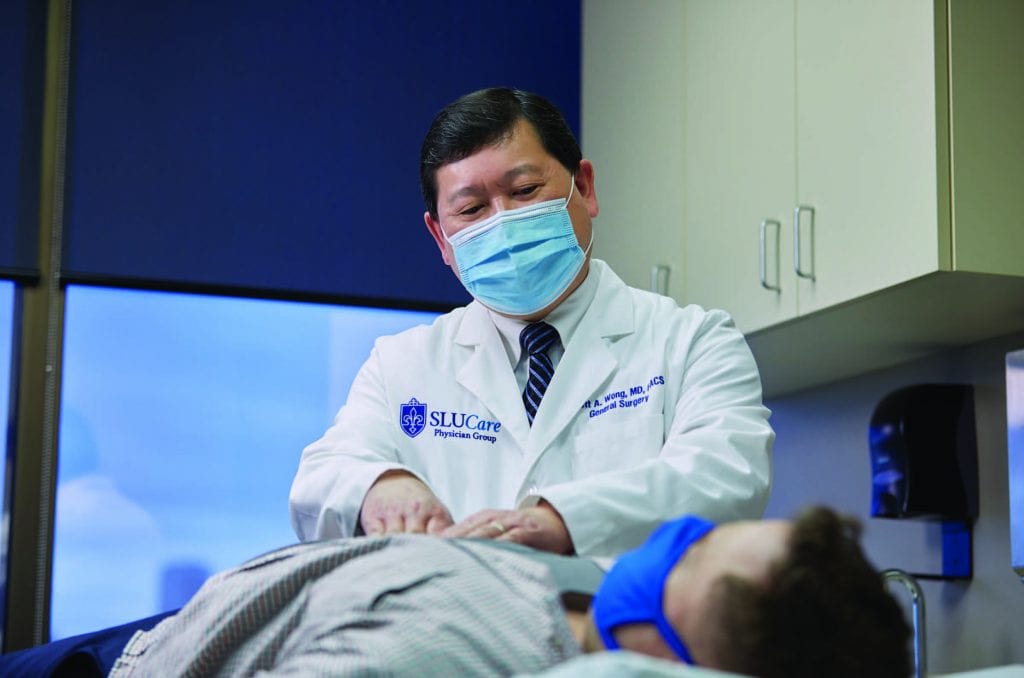When St. Louisan Bill Wilson developed an abdominal hernia a couple of years after prostate surgery, the effects were very visible. “I noticed a large bulge under my skin,” he says. “Each time I digested food, it would protrudeeven more, and sometimes it caused pain and discomfort.” That spurred him to visit his primary physician, who referred him to SLUCare surgeon Dr. Scott Wong.
Wilson says the hernia opening was about 3 inches long, so it was quite pronounced. “When I returned to activities like heavy lifting and yard work after the prostate surgery, I didn’t realize I was overdoing it,” he notes. “That caused a weakening of my abdominal muscles near the surgical site and created an opening that my small intestine poked through.” Wong recommended minimally invasive, robot-assisted laparoscopic surgery that would place a mesh implant to repair the opening and keep the patient’s intestine in place.
Wilson’s procedure was performed at SSM Health St. Mary’s Hospital. “He had what we call an incisional ventral abdominal wall hernia,” Wong says. “His small bowel protruded into the hernia defect, especially when he coughed or stood up.”
According to Wilson, his recovery has gone smoothly, and he appreciates the less invasive techniques surgeons can use today. “I’m in my 70s, but I still work full time, and it was important for me to be back in action as soon as possible,” he says. “Fifty years ago, I had knee surgery that came with large incisions, a long hospital stay and significant scars, so I have a personal perspective on the benefits of smaller incisions and shorter recovery times. It’s wonderful that surgeons can get people back on their feet faster, with less pain and discomfort.”
Wong used the hospital’s da Vinci Xi robotic system to repair Wilson’s hernia. “During the procedure, the surgeon sits at an ergonomic computer station in the corner of the operating room,” Wong explains. “I can control the system from there, and there is a high-tech 3D camera that offers better depth perception inside the surgical site. It allows the surgeon to get a clear, crisp view, and robotic arms can be manipulated and rotated like a human wrist.” He says the robotic system also allows for precise suturing and access to spaces in the body that are not easy to reach, and it can be used for other procedures like complex cancer surgeries.
He adds that before an operation is scheduled, the SLUCare surgeon meets with the patient to discuss treatment and surgery options and decide what is best for the person’s health and lifestyle. Some people are good candidates for robotic procedures, and others may be best served by traditional laparoscopic surgery, he notes.
“Dr. Wong and the SLUCare staff were very thorough in caring for me and answering my questions,” Wilson says. “He did a great job of explaining what to expect from the surgery, and everyone was accommodating and helpful. That gave me a lot of confidence going into the operating room, and the follow-up and results have been excellent. I’m feeling much better and looking forward to returning to my work and favorite activities.
Patients can expect thorough, compassionate care and attention from SLUCare’s experienced surgical staff. Pictured on the cover: SLUCare surgeon Dr. Scott Wong. For more information, call 314.977.4440 or search for ‘general Surgery’ at slucare.edu.
Cover design by Julie Streiler
Cover photo courtesy of SLUCare Physician Group
Pictured at top: SLUCare surgeon Dr. Scott Wong examines a patient.
Cover photo courtesy of SLUCare Physician Group
